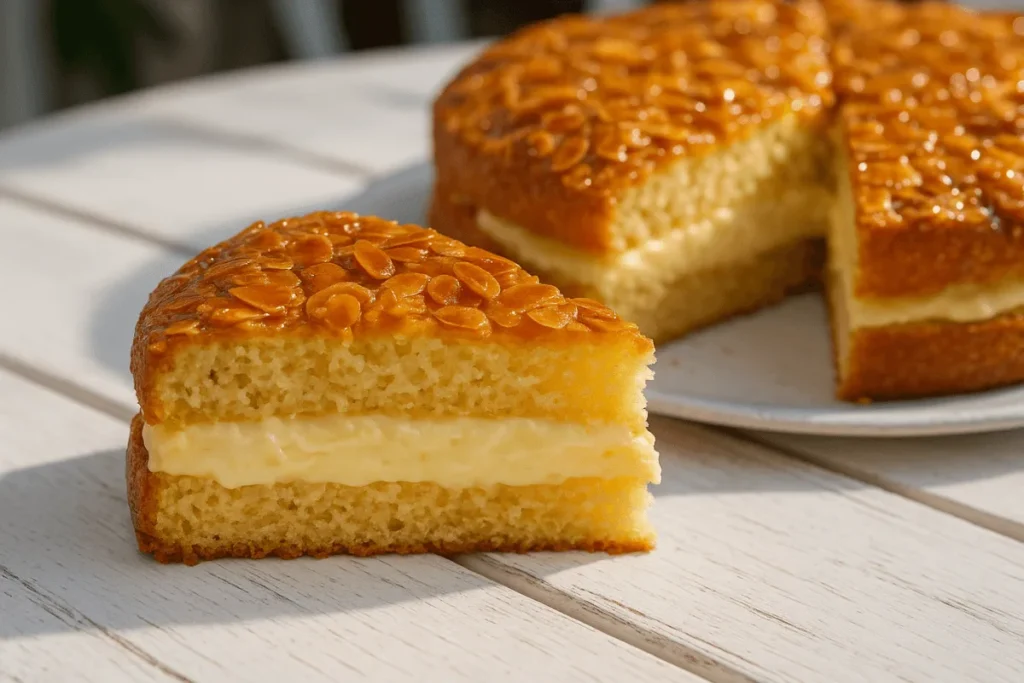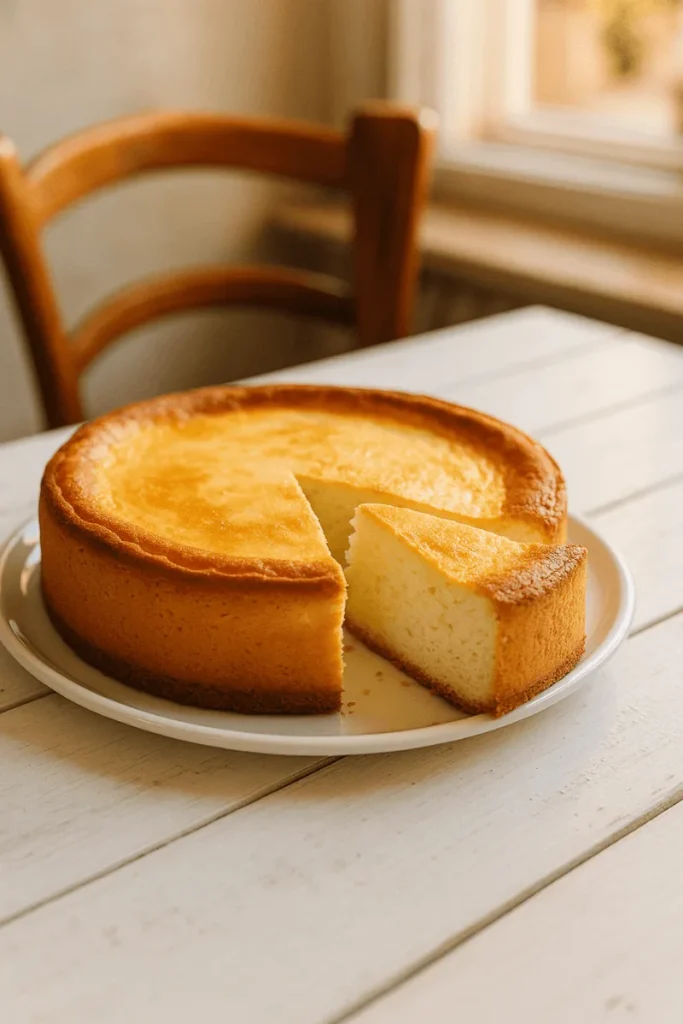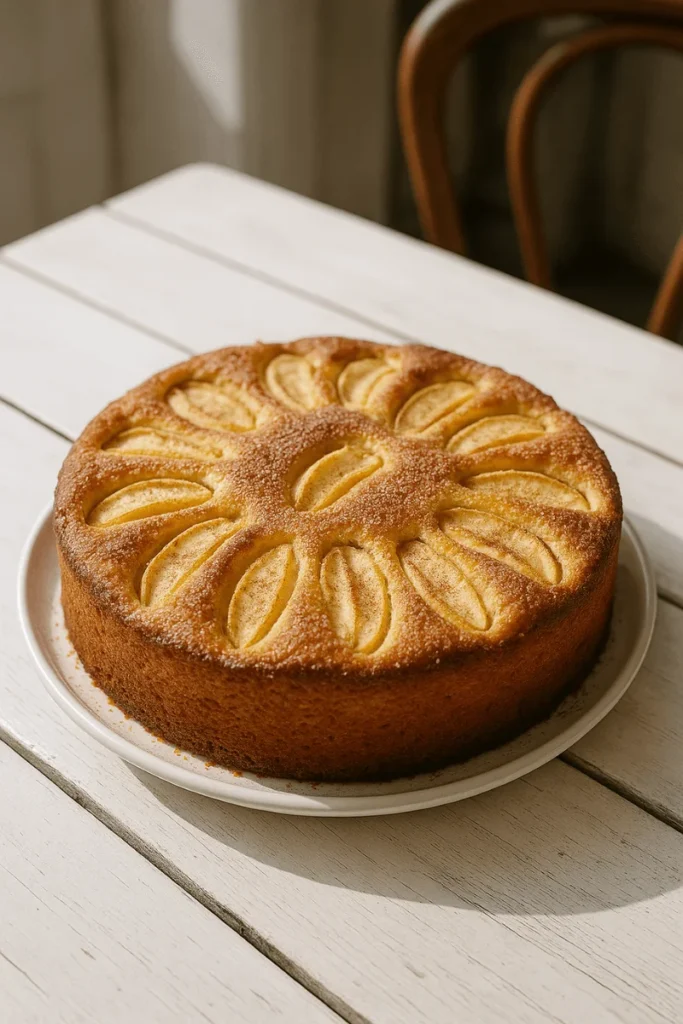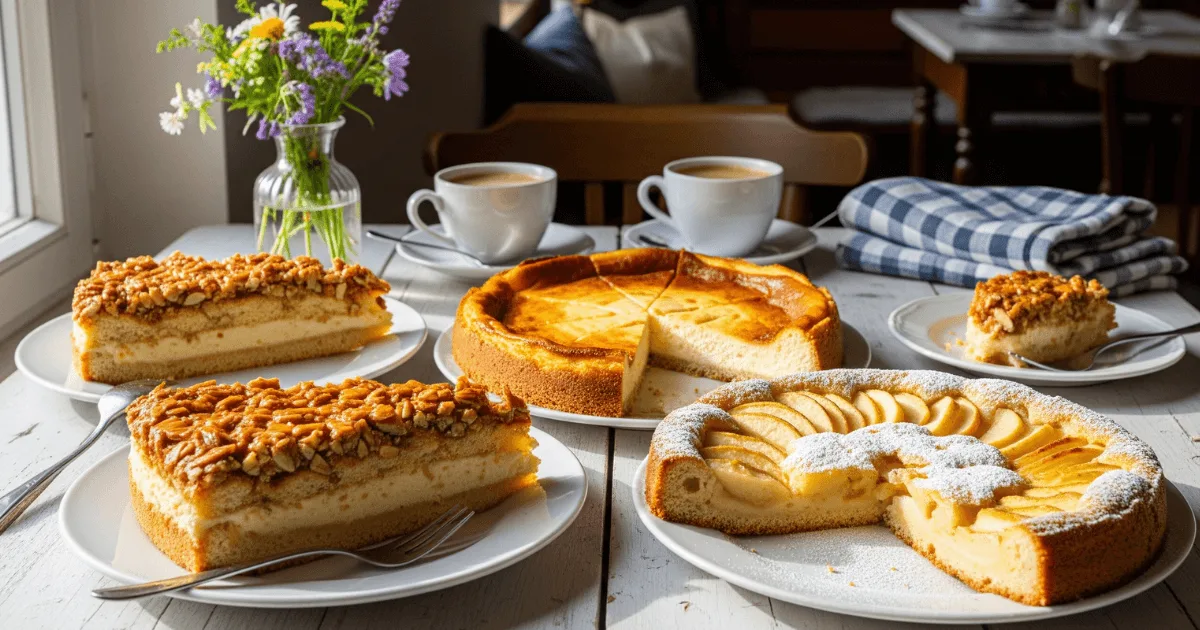If you assume Germany is only about sausages and schnitzel, it’s time to rethink! The real sweet magic happens with their desserts. Germans take their coffee-and-cake time, aka Kaffee und Kuchen, super seriously—it’s like a daily little celebration. And here’s the good news: a bunch of their classic cakes might look fancy, but they’re actually pretty chill to make at home.
I’m gonna walk you through three of my favorite easy German Desserts that’ll have you feeling like a legit baker in no time.
Table of Contents
Our 3 Classic Easy German Desserts
German Desserts come in all shapes and flavors—fruity, creamy, crunchy—you name it. I selected three options that are sure to please a crowd and are also suitable for beginners: Bienenstich (Bee Sting Cake), Käsekuchen (German Cheesecake), and Versunkener Apfelkuchen (Sunken Apple Cake). These babies truly show off what German baking’s all about, and trust me, they taste way better than they sound!
1. Bienenstich (Bee Sting Cake)
So, Bienenstich translates to “Bee Sting Cake,” which sounds kinda wild until you hear why: the honey-almond topping is so dang sweet and yummy that apparently, it attracts bees! (Don’t worry, no actual bees in the cake.) Think fluffy yeast cake, silky vanilla cream, and a crispy honey-almond crunch on top. It’s a showstopper but not as fancy as it looks.
Why You’ll Love It
Impress your friends without losing your mind in the kitchen. This cake has layers for days—soft dough, creamy filling, and that crackly, sticky top. Serve it at your next hangout and watch the compliments roll in.
You’ll Need (Ingredients)
For the Cake:
- 2 ½ cups flour
- 1 packet active dry yeast (yep, the little magic dust)
- ¼ cup sugar
- ½ tsp salt
- 1 cup warm milk
- 4 tbsp butter, softened
- 1 egg
For the Topping:
- 6 tbsp butter
- ½ cup sugar
- 3 tbsp honey
- 2 tbsp heavy cream
- 1 cup sliced almonds
For the Cream Filling:
- 1 package vanilla pudding mix (the cook-and-serve kind)
- 2 cups milk
- ¼ cup sugar
- 1 tsp vanilla
- ½ cup whipped heavy cream

How to Make It
- Mix the flour, yeast, sugar, and salt. Add warm milk, butter, and an egg to the mixture, then knead the dough for about 5 minutes until it achieves a smooth texture. Place it in a warm location for around an hour until it has grown to double its size.
- While the dough rises, melt the butter, sugar, honey, and cream over medium heat, then stir in the almonds—your glossy topping’s ready!
- Punch down the dough and split it in two. Press one half into a greased pan to form the bottom layer. Roll out the other half, spread the almond topping evenly on it, and place it on a separate pan.
- Bake both pans at 350°F (175°C) for 20-25 minutes until golden. Let them cool completely.
- Make the pudding as per the instructions on the package, then set it aside to cool. Fold in the whipped cream.
- Slice the plain cake horizontally, spread the cream filling inside, and sandwich it with the almond-topped layer. Voilà!
2. Käsekuchen (German Cheesecake)
Forget what you know about dense American cheesecakes—Käsekuchen’s a whole different vibe. It’s lighter, tangier, and uses Quark (a kind of fresh cheese) or a yogurt & cottage cheese mix. Totally dreamy and not too heavy.
Why You’ll Love It
Tastes fancy but super easy. You can add a crust or skip it for gluten-free vibes. It’s perfect when you want cheesecake without feeling like you’ve swallowed a brick.
You’ll Need
Filling:
- 3 cups Quark, or blend 2 cups Greek yogurt with 1 cup cottage cheese
- 1 cup sugar
- 4 eggs
- ½ cup melted butter
- ½ cup milk
- 3 tbsp cornstarch
- 1 tsp vanilla
- Zest of 1 lemon
For the Crust (Optional):
- 1¼ cups flour
- ½ cup sugar
- ½ tsp baking powder
- 4 tbsp cold butter, cubed
- 1 egg

How to Make It
- If making the crust: mix flour, sugar, and baking powder, then cut in the butter until crumbly. Add the egg and press the crust into the pan.
- Whisk together Quark, sugar, and eggs until smooth. Stir in butter, milk, cornstarch, vanilla, and lemon zest.
- Pour the filling into your pan (with or without crust).
- Bake at 325°F (160°C) for 60-75 minutes—the center should jiggle slightly like a good cheesecake.
- Turn off the oven and crack the door open, letting the cheesecake rest inside for an hour to prevent cracks. Place in the fridge for at least 4 hours, or better yet, leave it overnight.
3. Versunkener Apfelkuchen (Sunken Apple Cake)
Versunkener Apfelkuchen dessert is reminiscent of a comforting, apple-filled hug straight from Germany. The apples kinda sink into the batter as it bakes, giving you juicy bites of sweet and soft fruit. Perfect for a no-fuss dessert that still feels homemade and special.
Why You’ll Love It
Simple ingredients, straightforward steps, and an apple cake that basically bakes itself. Great for when you want a cozy cake without drama.
You’ll Need
- 1 cup butter, soft
- 1 cup sugar
- 3 eggs
- 2 cups flour
- 2 tsp baking powder
- ½ cup milk
- 1 tsp vanilla
- 2-3 tart apples (Granny Smith works well), peeled, cored, and sliced
- 1 tbsp lemon juice
- 1 tsp cinnamon
- 1 tbsp sugar (for sprinkling)

How to Make It
- Toss apple slices with lemon juice and a little cinnamon to prevent browning.
- Beat the butter and sugar until they turn light and fluffy, then gradually add the eggs one at a time. Mix the flour and baking powder, and gradually incorporate them with milk.. Stir in vanilla.
- Pour the batter into a greased pan, arrange apples on top, and gently press them in. Sprinkle sugar and cinnamon over the apples.
- In a preheated oven set to 350°F (175°C), bake for 45-55 minutes until the surface is golden and a toothpick inserted into the center comes out without any residue.
- Let cool slightly before serving. FYI: warm with vanilla ice cream? Heaven.
Dive into German Baking Traditions
German Desserts are more than just desserts—they’re little stories baked with love. Whether you’re digging into the crunchy, creamy Bienenstich, the light-as-air Käsekuchen, or the homey Apfelkuchen, you’re getting a taste of Germany’s sweetest traditions.
Plus, taking part in Kaffee und Kuchen means slowing down and savoring moments with people you care about. Ready to bring a bit of that charm into your kitchen? These recipes prove German baking can be simple, delicious, and a whole lot of fun.
FAQ
What’s a must-try sweet at Oktoberfest?
If you only try one thing, make it the Lebkuchenherzen — those giant gingerbread hearts covered in colorful icing. They’re less about eating (honestly, they’re kinda hard) and more about the vibe. People buy them as gifts with cute (sometimes cheesy) messages written on them. In essence, it’s a love note you can eat.
Wait, is “Kugel” a German dessert?
Nope, that’s a mix-up! In German, Kugel just means “ball.” The famous noodle pudding called “kugel” is actually a Jewish dish, not something you’ll find in German bakeries. So, if someone offers you “Kugel” in Germany, they’re probably just pointing at something round.
What’s the German word for cake?
Good question! It depends:
Every day, simple cakes (like apple cake) = Kuchen
Fancy, layered, cream-filled masterpieces = Torte
Think of Kuchen as the chill, no-fuss cousin… and Torte as the one who shows up overdressed to every party.
Speaking of Torte, what makes it special?
Layers, baby. Lots of layers. Plus rich fillings like cream, cherries, nuts, or chocolate. The most famous? The Black Forest Cake (Schwarzwälder Kirschtorte) — chocolate, cream, cherries, and a splash of cherry schnapps. Basically, dessert royalty.
And Kuchen is the simpler version?
Exactly. Kuchen is cozy, homey, “baked by grandma on a Sunday” kind of cake. It could be a sheet pan of apple slices baked into fluffy batter (Apfelkuchen) or a sweet crumb-topped one (Streuselkuchen). Comfort food in cake form.

